2022.07.04.43
Files > Volume 7 > Vol 7 No 4 2022
The relationship between the infestation of Whitefly Bemisia tabaci (Hemiptera: Aleyrodidae) and the chlorophyll content in different Eggplant varieties
1 Department of Plant Protection, College of Agricultural Engineering Sciences, University of Baghdad; [email protected];
2 Plant Protection Directorate, Ministry of Agriculture, [email protected].
* Correspondence author: [email protected]
Available from: http://dx.doi.org/10.21931/RB/2022.07.04.43
ABSTRACT
The sweet potato whitefly, Bemisia tabaci (Hemiptera: Aleyrodidae), is one of the most important pests in vegetables. Although the host plant Solanum melongena, is considered the most preferred, the whiteflies have preferences for particular varieties of eggplant. In this study, we evaluated three eggplant varieties in choice feeding tests. We found that the varieties of Zomorrod and Barcelona were the most preferred with the highest numbers of whitefly nymphs, which were 312 and 300 per leaf, respectively, on the last week of May. In comparison, the nymph average was 171.8 per leaf on the last week of May on the kareema. Chlorophyll concentration has been negatively affected by the infestation of B. tabaci. The investigation of the chlorophyll content ratio between the uninfested and infested eggplant leaves showed a decrease in chlorophyll content at 13.95 and 6.60 11 mg/L of the Zumorrod variety for the uninfested and infested leaves, respectively, with 52.67% chlorophyll reduction. At the same time, the mean chlorophyll content for uninfested and infested eggplant leaves of the Barcelona variety was 12.74 and 4.95 mg/L, respectively, with 61.14% chlorophyll reduction. At the same time, the Kareema variety was recorded at 17.49 and 4.95 mg/L for the uninfested and infested leaves, respectively, with 72.39% chlorophyll reduction. Furthermore, feeding by B. tabaci reduced leaf photosynthesis in eggplant by restricting gas exchange through stomata and reducing chlorophyll's content and photosynthetic capacity.
Keywords: population density; piercing pest; Bemisia tabaci; Solanum melongena; host preference; plant pigments
INTRODUCTION
Eggplant Solanum melongena L. is an important vegetable crop cultivated for its fruits. It is also known as brinjal, aubergine, garden egg, or guinea squash in countries 1. Although India and Afghanistan are considered the original homeland of eggplant plants, eggplant cultivation is currently widespread in all regions of the world 2. Several varieties of eggplant fruits show a wide range of shapes and colors, ranging from long elongated to oval to ovoid-shaped fruits, displaying multiple colors spanning from shades of purple, yellow, and green to white. Among the various factors that may cause the eggplant's low productivity is the damage caused by many pests, such as different species of aphids, mites, moths, and the whitefly Bemisia tabaci (Gennadius) 3.
The whitefly B. tabaci (Gennadius) (Hemiptera, Aleyrodidae) is a species complex with a worldwide distribution, considered a severe pest on several plant families, including Solanaceae 4. Throughout the whitefly life cycle, it feeds on the leaves, causing direct and indirect damage to the host plant by piercing leaves, sucking sap, and producing honeydew (on which sooty mold develops). It also affects growth, photosynthesis, and chemical and phonological processes 5-6, in addition to transmitting a wide range of virus diseases such as Tomato yellow leaf curl virus (TYLCV), tomato chlorosis virus (ToCV), sweet potato chlorotic stunt virus (SPCSV), mild cowpea mottle virus (CpMMV), melon yellowing-associated virus (MYaV), lettuce infectious yellows virus (LIYV), tobacco mosaic virus (TMV), and tomato mosaic virus (TMV) 7. The sweet potato whitefly B. tabaci is well known that the whitefly infestation on vegetables causes a reduction in chlorophyll content and other pigmentations in the infested plants 8. Whitefly nymphs usually cause chlorosis in infested leaves 9. The result of the decrease in the concentration of chlorophyll negatively affects the photosynthesis process and leaf gas exchange 8.
The control of B. tabaci is a challenge because of the several generations annually developing and its ability to acquire resistance to insecticides quickly 10. Over the years, many studies on the plant host preferences of B. tabaci and host suitability among different plant varieties have been carried out 5, 11-14. Furthermore, several studies focused on the effect of host plant growth by whitefly infestation, such as the age and population size of whitefly infestation and the ability to reproduce it 15. However, the physiological and biochemical changes caused by B. tabaci in the infected plant hosts were not seen. This study aimed to assess the impact of B. tabaci on the chlorophyll concentration of some eggplant varieties.
MATERIALS AND METHODS
Prepared greenhouse and growth conditions
The study was conducted at the University of Baghdad, Agricultural Engineering Sciences, located at the Al-Jadriyah Campus. Different varieties of hybrid eggplants Barcelona F1 (Fito Semillas company, Barcelona, Spain), Zomorrod F1 (Enza Zaden company, Netherlands), and Kareema F1 (Vilmorin Seed Generation Company, Paris, France) were obtained from the local market. Seeds were sown in a planting tray filled with potting mix under controlled conditions and kept free from pest and disease infestations. The seedlings of eggplants were transferred to the greenhouse (9 × 13 m2) till the seedlings reached 2-4 leaves. Eggplants were irrigated and fertilized with NPK fertilizers. The greenhouse was divided into five plots with 10 planting rows. Each plot was cultivated with one variety of eggplant and was divided into 5 plots containing 10 eggplant plant seedlings, in a total of 50 plants per variety.
Population Density Calculation
Five leaves were taken from each eggplant variety and replicated each week randomly during April and May to calculate the nymph number of whitefly B. tabaci on both surfaces of the leaves for the three varieties of eggplants mentioned above. The samples of eggplant leaves were placed into zip lock bags with initial details such as the name of the eggplant variety, collection date, and the replicate number. The zip bags were transferred to the laboratory, examined using a stereomicroscope and needle on the same day of sample collection, and counted the nymph number.
Chlorophyll content
Based on Goodwin's method (16), the concentration of chlorophyll in the uninfested and infested leaves of three varieties of eggplants (Zomorrod, Kareema, and Barcelona) was measured by using a spectrophotometer; uninfested leaves were taken from plants regularly sprayed by chemical pesticides to prevent pest infestation. Uninfested and infested leaves extraction were prepared with three replicates. Five leaves were taken from uninfested and infested leaves from each variety for each replicates separately, leaves drying under laboratory conditions, and mortar and pestle were used for crushing the leaves. A quantity of 0.2 g of leaf powder was taken from each treatment, placed in a glass vial, added a volume of 20 ml of acetone / water (80:20) solvent, and left for 24 hours. The extract was placed on a spectrophotometer port to measure chlorophyll content for each replicate from each variety. To calculate the absorbance of the grape leaf extract sample, the wavelengths 663 nm and 645 nm were set up in the spectrophotometer to estimate the amount of chlorophyll in each instance by the concentration of (mg/mL) according to the following equations:
Chlorophyll a (mg/mL) = 12.7 D (663nm) – 2.69 D (645nm)
Chlorophyll b (mg/mL) = 22.9 D (645nm) – 4.68 D (663nm)
Total chlorophyll (mg/mL) = 20.2 D (645nm) +8.02 D (663nm)
Where D represents the spectrophotometer reading, 20.2 and 8.02 mg/g referred to the absorbance of chlorophyll a and b at 645 nm and 663 nm, respectively.
% reduction of chlorophyll was calculated by the equation below as described by Farina et al. 23:

Statistical analysis
All field tests were conducted using the Randomized Completely Block Design (RCBD) utilizing the statistical analysis program SPSS version 26 to analyze variance (ANOVA) on the data. The chlorophyll content of uninfested and infested eggplant leaves with whiteflies from each tested variety was compared using the least significant difference (LSD) under the probability level of 0.05.
RESULTS
The population of whitefly B. tabaci nymphs in the three varieties of eggplant: Kareema, Barcelona, and Zumorrod, from the beginning of April to the end of May, are reported in Figure 1. It is shown that three peaks of the whitefly B. tabaci population began to gradually increase to reach their first peak, and the average of whitefly nymphs was 45.4, 52 and 40 nymphs per leaf in the last week of April for the varieties of eggplant Barcelona, Zumorrod, and Kareema, respectively. While, the average population of whitefly nymphs was recorded to reach the second peak of whitefly nymphs density of 274.2, 381.6, and 148.4 nymphs per leaf in the second week of May for the three eggplant varieties Barcelona, Zumorrod, and Kareema, respectively. However, the average population density of whitefly B. tabaci nymphs was recorded at 300, 312 and 171.8 nymphs per leaf on the last week of May for Barcelona, Zumorrod, and Kareema, respectively. Statistically, there were significant differences between the three eggplant varieties in the severity of whitefly B. tabaci between these three varieties, the highest infestation of the whitefly in the nymph instar was on Zumorrod, followed by Barcelona, and then Kareema was the least.
The population density of the whitefly nymph on the two eggplant varieties, Barcelona and Zumorrod, was more sensitive to whitefly infestation than Kareema. The infestation of whitefly on different eggplant varieties may return to eggplant morphological characteristics.
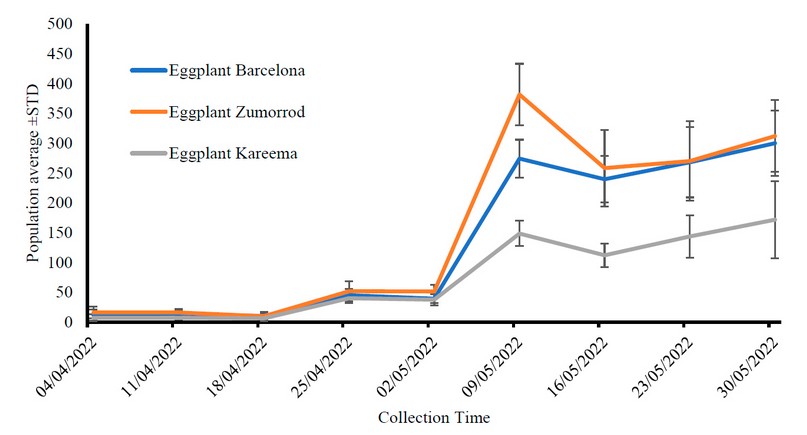
Figure 1. Population density of whitefly B. tabaci nymphs on three varieties of eggplant (Zumorrod, Barcelona, and Kareema).
The current study demonstrated that the whitefly, B. tabaci, feeding on host eggplant decreased the concentration of plant pigments, especially chlorophyll a, chlorophyll b, and total chlorophyll. Plant sap, which contains plant pigments like chlorophyll, can cause reduced in the plant colors of the sap when directly sucked. There was a significant difference in the content of both chlorophyll a and b between uninfested and infested eggplant leaves for all varieties. The range of both chlorophylls a and b was 9.75 and 4.19 mg/L for uninfested and 3.16 and 3.43 mg/L for infested leaves of Zumorrod variety, respectively. While in the Barcelona variety, the chlorophyll was recorded for both chlorophyll a and b at 8.68 and 4.07 mg/L for uninfested leaves and 2.91 and 2.03 mg/L for infested leaves with whitefly, respectively. Moreover, the variety of Kareema was 12.53 and 5.41 mg/L for the content of both chlorophylls a and b in the uninfested leaves, respectively. On the other hand, the concentration of chlorophylls a and b were 3.08 and 2.07 mg/L, respectively, in the infested leaves of Kareema (Table 1 and Figure 2).
The data on total chlorophyll content in different varieties of eggplant showed significant differences in the mean content of total chlorophyll between uninfested and infested leaves of different varieties of eggplant with whitefly B. tabaci. Table 1 also demonstrates that the mean content of total chlorophyll was more significant than infested leaves as shown in Zumorrod variety 13.95 and 6.60 mg/L for uninfested and infested leaves, respectively. At the same time, the total chlorophyll of the eggplant Barcelona variety was 12.74 and 4.95 mg/L in uninfested and infested eggplant, respectively. In addition, the array of Kareema was read at 17.49 mg/L of total chlorophyll in uninfested leaves compared with 4.95 mg/L in infested eggplant leaves Figure 2.
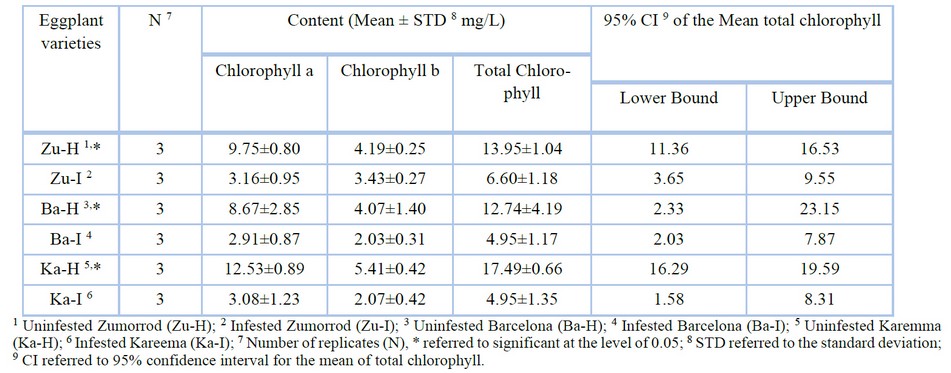
Table 1. The comparison between different uninfested and infested varieties of eggplants (Zumorrod, Barcelona, and Kareema) with whitefly Bemisia tabaci in chlorophyll content.
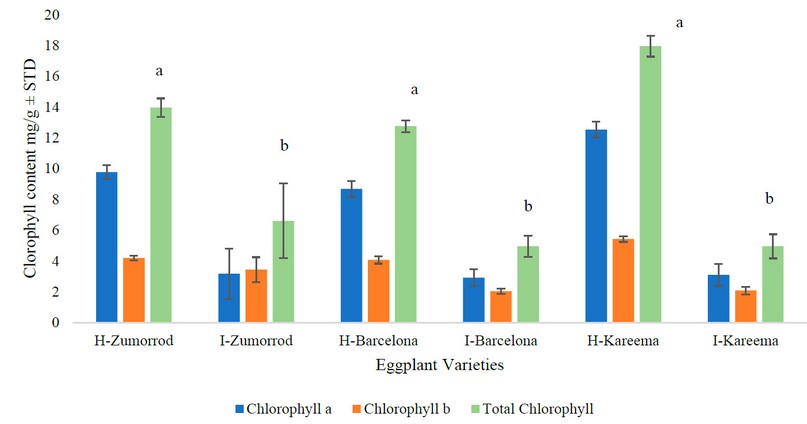
Figure 2. The concentration of chlorophyll content (mg/L) ± STD in various uninfested and infested eggplant varieties (Zumorrod, Barcelona, and Kareema) with whitefly Bemisia tabaci. Different litters mean significant differences at the level 0.05 for total chlorophyll.
The values of chlorophyll a, b, and total chlorophyll decreased under the feeding stress of B. tabaci. The following means of chlorophyll content (Table 2) indicated that the reduction of chlorophyll content had significantly less chlorophyll a, b, and total chlorophyll in infested than uninfested eggplant leaves, as represented in Zumorrod variety chlorophyll a was 67.57%, chlorophyll b 18.12% and total chlorophyll 52.67%. The results showed that the reduction percentage of chlorophyll a, b and total chlorophyll in the Barcelona variety was 66.37, 50.12, and 61.14%, respectively. Similarly, the chlorophyll content values were 75.39, 61.66, and 72.39% in the Kareema variety. The whitefly B. tabaci infestation on different varieties of eggplant significantly reduces chlorophyll content compared with uninfested eggplant leaves (Figure 3).
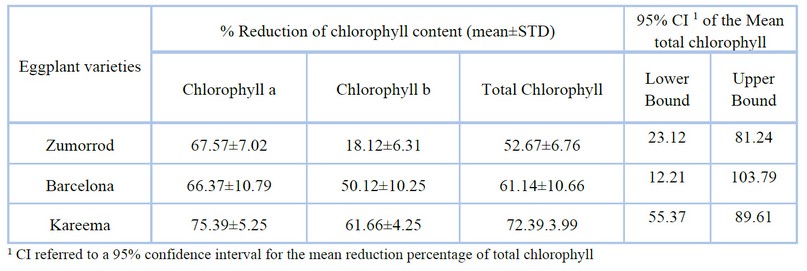
Table 2. The percentage of chlorophyll reduction in different varieties of eggplant (Zumorrod, Barcelona, and Kareema) caused by whitefly Bemisia tabaci.
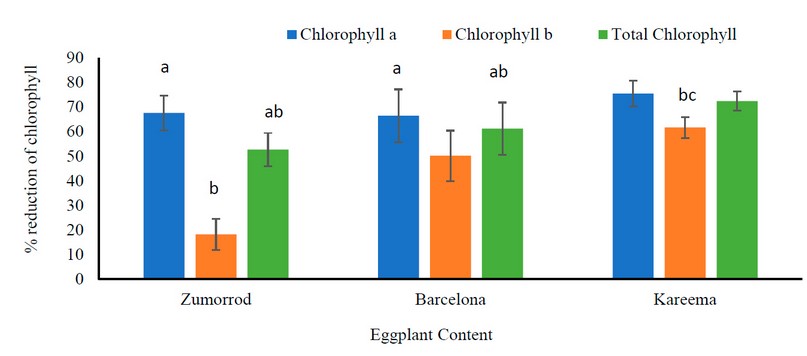
Figure 3. The percentage of chlorophyll reduction caused by the infestation of whitefly B. tabaci. Different litters mean there were significant differences at the level 0.05 for chlorophylls a, b and total chlorophyll.
DISCUSSION
The preferences of whiteflies for several eggplant varieties (Zumorrod, Barcelona, and Kareema) were evaluated in this study. The investigation was conducted every week during the study time. The density of the whitefly nymph population on the two eggplant varieties, Barcelona and Zumorrod, was more susceptible to whitefly infestation than Kareema. A similar result was observed by 17 Proved that the two eggplant varieties, H149 and JSZ, were more preferred for feeding and egg-laying by whiteflies than other studied varieties, and adult whiteflies lived longer on these varieties. On the other hand, infection with B. tabaci reduces percentages in various growth parameters of eggplant, such as leaf area, fresh leaf weight, dry leaf weight, chlorophyll content, and rate of Photosynthesis 18. This is consistent with our results, and significant differences were reported between uninfested leaves and the infested leaves of the three varieties (Zumorrod, Barcelona, and Kareema). According to our study findings, feeding by whitefly B. tabaci decreased the number of plant pigments such as chlorophyll a, b, and total chlorophyll. The reduced levels of chlorophyll may be because of sucking on plant sap containing plant pigments. Due to the lowering level of chlorophyll content as a result of B.tabaci feeding compatible with 19-20 who mentioned that the concentration of chlorophyll changes in the plant during its growth or as a result of external pressure, such as infestation with sup-sucking insects that feed on plants sap 21,23.
Moreover, the feeding of B. tabaci caused a decrease of 9.7% and 65.9% in both chlorophyll content and photosynthesis rate, respectively, in eggplant leaves. Aside from reducing the photosynthesis rate, Shannag 22 pointed out that the infestation of B. tabaci also reduces the rate of water content by 32% more than uninfested plants. Because of the loss of chlorophyll, the injury may reduce photosynthesis, reducing the quantity and quality of eggplants. Chlorophyll can be reduced by sucking pests' infestations, and the chlorophyll concentration can change during the growth and development of the eggplant contents. Additionally, we found that uninfested eggplant plant chlorophyll content values were higher than those of infested plants. In eggplant plants, feeding activity by both nymphs and adults of whitefly B. tabaci reduces the amount of chlorophyll a, b, and total chlorophyll in the leaves. It has a detrimental effect on the rate of transpiration and photosynthesis.
CONCLUSIONS
From these results, we conclude that B. tabaci varies in the severity of infection between the three variants, the highest condition of the whitefly was in Zumorrod. Barcelona, and the least was Kareema. This injury accompanies by a significant reduction in chlorophyll concentration in the infected leaves compared with uninfested leaves. Furthermore, a significant decrease in chlorophyll concentration in the infected leaves compared with uninfested leaves; a reduction in leaf photosynthesis leads to lower production.
Author Contributions: Conceptualization, Q.A.; methodology, A.R., Q.A. and M.A.; validation, A.R., Q.A. and M.A.; formal analysis, Q.A.; investigation, A.R. and Q.A.; resources, Q.A.; data curation, A.R., Q.A. and M.A.; writing—original draft preparation, A.R. and Q.A.; writing—review and editing, A.R., Q.A. and M.A.; visualization, A.R., Q.A. and M.A.; supervision, Q.A.; project administration, Q.A. All authors have read and agreed to the published version of the manuscript.
Funding: This research received no external funding.
Institutional Review Board Statement: Not applicable.
Informed Consent Statement: Not applicable.
Acknowledgments: We thank the University of Baghdad for its research support.
Conflicts of Interest: The authors declare no conflict of interest.
REFERENCES
1. Alam, I.; Salimullah, M. Genetic engineering of eggplant Solanum melongena L.: Progress, controversy and potential. Horticulturae 2021, 7(4): 78.
2. Hui, Y.H. Handbook of food science, technology, and engineering. CRC press, USA, 2006; Vol. 149.
3. Mishra, M. S. Insect pests of crops-principles and practices in: Handbook of Agricultural Sciences (S. S. Singh ed.), Kalyani Publishers, New Delhi. India, 2002; Pp. 325 401.
4. Ying, J.I.N.G.; Jian, H.U.A.N.G.; Rui‐yan, M.A.; Ju‐cai, H.A.N. Host plant preferences of Bemisia tabaci Gennadius. Insect Sci 2003, 10(2):109-114.
5. Nabity, P.D.; Zavala, J.A.; DeLucia, E.H. Indirect suppression of photosynthesis on individual leaves by arthropod herbivory. Ann bota 2009, 103(4): 655-663.
6. Thangavel, B.; Palaniappan, K.; Manickavasagam, P.K.; Subbarayalu, M.; Madhaiyan, R.; Soibam, B.S. Microbial control of the exotic spiralling whitefly, Aleurodicus dispersus (Hemiptera: Aleyrodidae) on Bemisia tabaci eggplant using entomopathogenic fungi. Afri J Microbio Res 2015, 9(1):39-46.
7. Navas-Castillo, J.; Fiallo-Olivé, E.; Sánchez-Campos, S. Emerging virus diseases transmitted by whiteflies. Ann Rev phytopatho 2011, 49:219-248.
8. Masuda, K.; Kato, M.; Saito, T. Reduction in carotenoid and Chlorophyll content induced by the sweet potato whitefly, Bemisia tabaci. Scie Horti 2016, 200:102-104.
9. Hoelmer, K.A.; Osborne, L.S.; Yokomi, R.K. Foliage disorders in Florida associated with feeding by sweetpotato whitefly. The Florida Entomo 1991, 74(1):162-166.
10. Wang, R.; Zhang, W.; Che, W.; Qu, C.; Li, F.; Desneux, N.; Luo, C. Lethal and sublethal effects of cyantraniliprole, a new anthranilic diamide insecticide, on Bemisia tabaci (Hemiptera: Aleyrodidae) MED. Crop Protec 2017, 91:108-113.
11. Hasanuzzaman, A.T.M.; Islam, M.N.; Zhang, Y.; Zhang, C.Y.; Liu, T.X. Leaf morphological characters can be a factor for intra-varietal preference of whitefly Bemisia tabaci (Hemiptera: Aleyrodidae) among eggplant varieties. PLoS One 2016, 11(4):e0153880.
12. Bernays, E.A. When host choice is a problem for a generalist herbivore: experiments with the whitefly, Bemisia tabaci. Ecolo Entomo 1999, 24(3):260-267.
13. Naranjo, S.E. Conservation and evaluation of natural enemies in IPM systems for Bemisia tabaci. Crop Prot 2001, 20:835–852.
14. Shah, M.M.R.; Liu, T.X. Feeding experience of Bemisia tabaci (Hemiptera: Aleyrodidae) affects their performance on different host plants. PLoS One 2013, 8(10):e77368.
15. Rodríguez-Álvarez, C.I.; Muñiz, M.; Nombela, G. Effect of plant development (age and size) on the Mi-1-mediated resistance of tomato to whitefly Bemisia tabaci. Bull Entomo Res 2017, 107(6):768-776.
16. Goodwin, T. W. Chemistry and Biochemistry of Plant Pigment 2nd ed. Academic Press London N Y San Francisco, 1976, 373.
17. Hasanuzzaman, A.T.M.; Islam, M.N.; Liu, F.H.; Cao, H.H.; Liu, T.X. Leaf chemical compositions of different eggplant varieties affect performance of Bemisia tabaci (Hemiptera: Aleyrodidae) nymphs and adults. J Econ Entomo 2018, 111(1):445-453.
18. Islam, T.; Shunxiang, R. Effect of sweetpotato whitefly, Bemisia tabaci (Homoptera: Aleyrodidae) infestation on eggplant Solanum melongena L. leaf. J Pest Sci 2009, 82(3):211-215.
19. Samdur, M.Y.; Singh, A.L.; Mathur, R.K.; Manivel, P.; Chikani, B.M.; Gor, H.K.; Khan, M.A. Field evaluation of chlorophyll meter for screening groundnut (Arachis hypogaea L.) genotypes tolerant to iron-deficiency chlorosis. Curr Scie 2000, 79(2):211-214.
20. Lawson, T., Craigon, J.I.M., Tulloch, A.M., Black, C.R., Colls, J.J. and Landon, G., 2001. Photosynthetic responses to elevated CO2 and O3 in field-grown potato (Solanum tuberosum). Journal of Plant Physiology, 158(3), pp.309-323.
21. Jindal, V. Studies on Mechanisms of Resistance to Whitefly, Bemisia tabaci (Gennadius), In Cotton, Gossypium Hirsutum Linnaeus (Doctoral dissertation, Punjab Agricultural University; Ludhiana), India, 2004.
22. Shannag, H.K.; Freihat, N.M. Gas exchange of cucumber, Cucumis sativus L., impaired by tobacco whitefly, Bemisia tabaci (Gennadius) (Hemiptera: Aleyrodidae). Jordan J Agric Sci 2009, 5:295-305.
23. Farina, A.; Barbera, A.C.; Leonardi, G.; Massimino Cocuzza, G.E.; Suma, P.; Rapisarda, C. Bemisia tabaci (Hemiptera: Aleyrodidae): What Relationships with and Morphological Physiological Effects on the Plants It Develops on? Insects 2022, 13(4):351.
Received: August 25, 2022 / Accepted: October 12, 2022 / Published:15 November 2022
Citation: Raed, A.; Ahmed, Q.; Arif, M. The Relationship between the Infestation of Whitefly Bemisia tabaci (Gennadius) (Hemiptera: Aleyrodidae) and the Chlorophyll Content in Different Eggplant Varieties. Revis Bionat a 2022;7(4) 43. http://dx.doi.org/10.21931/RB/2022.07.04.43
